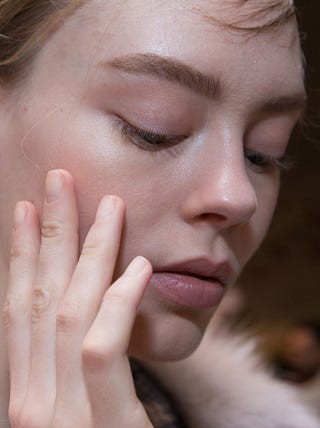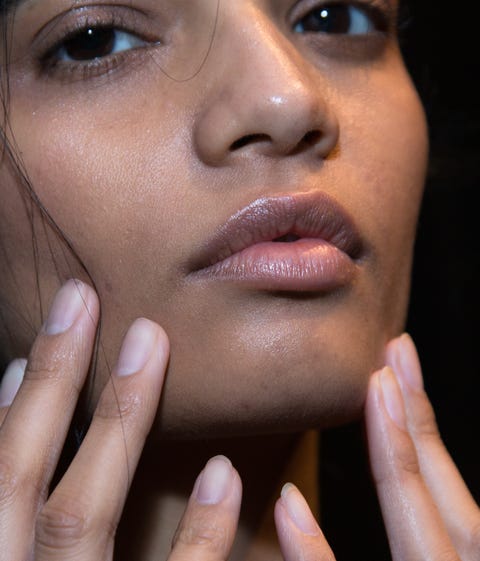I like to grind. Work-wise, dance-wise—let’s grind it out. But there’s an area I don’t appreciate grinding, and that’s my mouth. I remember when I first realized I was mercilessly grinding my teeth at night: I was on a shoot, getting ready to interview celebrity cosmetic dentist Bill Dorfman about teeth whitening. Before filming, he inspected my teeth to make sure everything was good to go.
“Your teeth are beautiful, but do you experience jaw pain?”
Thinking about it, yes, I did. My face and head felt sore all the time. I had more headaches in a month than I recalled having...ever (not related to politics at that point. Those were the days.) How did he know that? Turns out, my masseter muscle—more on this later—and teeth were a dead giveaway, specifically, my top incisors (the middle two teeth) and my cuspids (the canine teeth) of both my upper and lower jaw.
My cuspids had been sanded down from pointy to flat and straight-edged, and my front two teeth were uneven in length. These were the visual red flags that I had been getting my grind on. The masseter muscle is the muscle that helps you chew—it’s connected to your lower jaw and cheekbone. Because of my grinding, it’s like that muscle had been pumping iron: the constant chewing motion caused the muscle to become enlarged, altering the shape of my face. Dr. Dorfman cosmetically sanded my front two teeth so they were the same length and suggested I get a mouthguard to prevent future damage, but also suggested I look into the cause of this: TMJ.
What is TMJ?
“The TMJ is actually an acronym for temporomandibular joint,” said Dr. Lawrence Fung, DDS of Silicon Beach Dental in Culver City, California. “The TMJ consists of structures that connect the lower jaw to the upper jaw and are involved in everyday chewing. It is within the TMJ structures that make a substantial contribution to the production of maxillofacial—jaw—pain.”
“A lot of times patients will come in having self-diagnosed TMJ issues,” said Dr. Victoria Veytsman, DDS of Cosmetic Dental Studios in New York City. “This presents pain in the jaw, headaches, tightness, difficulty chewing, earaches, limited opening, locking and sometimes clicking. When you see your dentist, they may choose to do imaging to evaluate any sort of damage to the joint as well. It can cause pain anywhere in the face, jaw and neck.”
Sounds about right. Aesthetically, wearing down of the teeth is the most common clue that you’re grinding them, and can ultimately speed up the appearance of aging. “Teeth shorten in length over time, with grinding giving a more aged appearance to the smile and entire face,” said Dr. Veytsman. “Shorter teeth mean reduced lower third of the face proportionately and gives the illusion of an aging face much faster.”
Once I got my teeth to a good place aesthetically, I was desperate to find out how to ease the pain and protect them long-term. First and foremost, I got a nightguard moulded to my mouth at the dentist’s office. At the very least, I didn’t want to grind my teeth down anymore than I already had. Now, I wear mine religiously. I don’t see stress as something that will ever totally disappear from my life—unless winning the lottery is in my future—but taking the time for breathing exercises and meditation before bed has helped me relax and prepare myself for a peaceful sleep. A CBD pen from Beboe also currently helps.
I’ve also been offered several practical tips to help calm my jaw inflammation, like avoiding chewy foods and keeping Motrin on standby to help with pain. I even tested out acupuncture (yes, on my face) and myofacial massage—in which fingers are used to massage the inside of the mouth—but nothing truly alleviated the aching I experienced long-term except for Botox.
How Does Botox Help With Teeth Grinding?
Botox has several benefits. Of course, we know it as an injectable that helps with aging, but it can help lessen the aching of your jaw by stopping you from grinding your teeth.
“Botox correctly administered can be a great tool to help alleviate pain from grinding as it will help relax the muscles that are in pain,” said Dr. Fung. Officially, Botox is approved to relax the muscles in the face to prevent wrinkles from forming. In this case, it relaxes the masseter muscle and prevents it from overworking. I had noticed that my face was starting to look wider, and it was because I was building up those masseter muscles. Botox helps to lessen the appearance of this muscle—almost deflating it—so in addition to alleviating the clenching, it also slims your jawline. A great cosmetic bonus, in my humble opinion.
What Can Go Wrong?
I’ve been getting this done for two years now, and there’s a few things I’ve learned over time. First, I should note that getting Botox injections in the masseter muscle are not an on-label usage for the substance, so make sure you find a professional well-versed in the anatomy of the face. You can discuss with your cosmetic dermatologist or a preferred ENT physician, neurosurgeon or dentist. (On-label uses for Botox include treating “the look of moderate to severe forehead lines, crow’s feet lines, and frown lines between the eyebrows in adults,” according to the brand website.) Overall, I get these injections every four to six months, about 30 units in each masseter muscle. There is such a thing as getting too much Botox—if you watch Bravo, you’ve probably been exposed to this—so beware. Make sure that you consult your injector prior to getting these injections and ask them how long they’ve been administering injectables like Botox specifically for the masseter muscle.
“Ask [your provider] what can go wrong. If you ask a lot of questions about the procedure, then you know that that person has an understanding of the right technique and potential complications,” said Dr. Nancy Samolitis of Facile Dermatology and Boutique in Los Angeles. “If you ask what could go wrong and they say, ‘nothing!’ that’s a little worrisome.”
Like Dr. Samolitis said, research is critical in finding someone to administer these injections, or any injection. You want to make sure they have a good history of performing this treatment or else you could end up like I did at one point, with a crooked smile.
“The masseter muscle is located in close proximity to the muscles that make you smile,” Dr. Samolitis said. “The smile muscles are just a little more superficial. It’s very important that the person injecting you understands facial anatomy, because if the wrong muscle is injected or the Botox spreads to the smile muscle, you may not be able to smile for three to four months.”
This happened to me. (I’ll spare you photographic evidence.) As someone who works on-camera for a living, this was a costly mistake—we ended up not airing segments I had shot because of my obviously asymmetrical smile. Unfortunately, this isn’t an immediately fixable problem. “Sometimes it only happens on one side. Do you go and paralyze the other side? It’s not something you’re able to fix. You just have to wait it out,” said Dr. Samolitis.
Are Additional Services Needed?
Another thing to consider when getting this treatment is the potential loss of facial volume. Because Botox relaxes the muscles and can even shrink an overdeveloped muscle, you may experience loose skin that could result in needing supplemental filler, which can add to the price tag. (Typically, for 60 total units of Botox, the cost can range between $450-$600, depending on the strength and size of the muscle; it also depends on where you live and the price per unit.) I get filler in my chin to help with the volume loss as a result of grinding my teeth for years—not as a result of getting Botox for TMJ. It helps to fill out the chin area and lifts the corners of my smile as well.
It should also be noted that Botox won’t fix everything. “There are some people that say, ‘My joint clicks,’ or ‘It feels like my jaw is moving or cracking or popping,’ and those kinds of things cannot be corrected with Botox. That’s when I would refer someone to a surgeon who specializes in that procedure,” said Dr. Samolitis.
Who Isn’t a Good Candidate For This Service?
Because of the aesthetic benefits, many people may ask or seek this treatment just for the slimmer jaw, but this could actually cause problems in the long run.
“My main concern if somebody doesn’t have an enlarged muscle is that they could actually lose some of the definition of their jawline,” said Dr. Samolitis. Some people do Botox in the masseter just to make their jaw look slimmer—that’s become a popular trend. If you’re muscle is not overdeveloped, I’m not sure that’s a good idea for you long-term. If you’re an older person that maybe has some loose skin or jowls, we’re actually going to be depleting that volume that would be holding up that skin. The good news is when the Botox wears off, and then you start exercising that muscle again, it’s going to come back. It’s not something you have to live forever with.”
Overall, I try to space at my injections as long as I can stand to, but I really appreciate the results both physically and cosmetically of the Botox in my masseter muscle.




Comments
Post a Comment